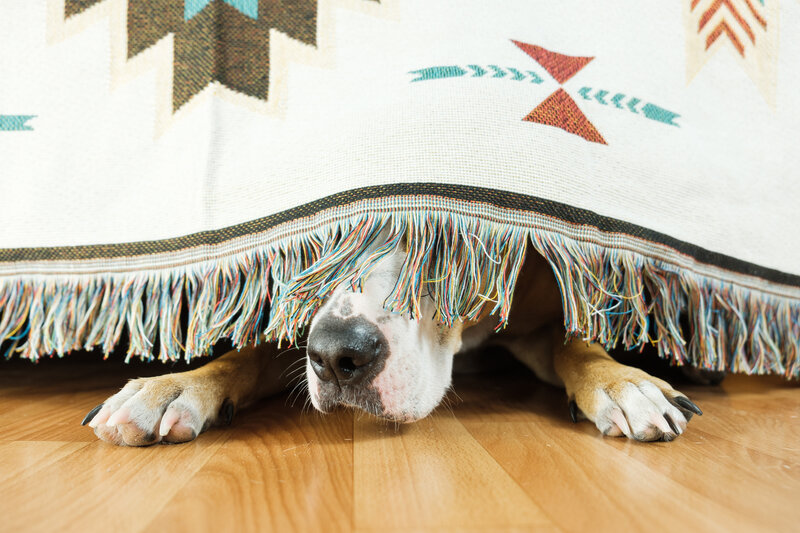
“Anxiety” answers most of the questions we get regarding, “Why does my dog (insert negative behavior trait(s)?)” Dogs express anxiety or nervousness in a wide range of ways, some of the most common being:
While everyone (including dogs) experiences occasional anxiety, chronic anxiety deserves to be addressed. Anxious dogs are often rehomed due to their undesirable behaviors or traits when all that is needed is accurate assessment, education, and training.
The first step is identifying the reason(s) your dog is so anxious. If you read through them and aren’t 100% sure, don’t hesitate to contact an experienced dog trainer in your area. We love nothing more than helping dogs and their canine companions understand one another better and learn how to maintain the loving boundaries that ensure everyone’s needs are met.
Here are some of the most common anxiety makers for dogs.
Dogs are sensitive and highly attuned to their environments. The familiar feels safe, and the unfamiliar activates nervousness or fear. This means a dog can become anxious:
The more you familiarize your dog with a variety of people, places, other dogs, and things, the better adjusted they’ll be in the presence of new or unfamiliar things in the future. We call this process “socialization,” and it doesn’t ever stop. Even if you did your due diligence initially, a well-socialized puppy or new-to-you dog could become increasingly nervous or anxious if you don’t continue exposing them to new things over time.
Do you work all day? Dogs are genetically programmed to live in a pack and move a lot (more on that next). This means that some dogs don’t fare well when left alone for long periods of time if they are not used to being left. When they’re left alone or their pack “leaves them,” some dogs experience separation anxiety. This is particularly common for certain breeds (Chihuahua, border collies, and other working dogs, labradors, etc.) and for dogs that were abandoned in the past (newly adopted dogs).
Does this mean you can’t get a dog if you work? Not at all. However, if your dog has a hard time spending long periods alone, we recommend ensuring they’re occupied. This can be done by:
Ensuring a solo dog is well exercised (so they’re worn out when you’re gone) is another great tool for minimizing anxiety of every type.
All dogs deserve daily exercise, but some breeds need more physical activity than others. We can’t express enough how important it is that people choose their dog breeds to align with their lifestyles rather than aesthetics. When you choose the right breed for your household, you’re already well on the way to avoiding unnecessary anxiety.
However, all dogs need at least one walk or run per day, and some need more playtime than others. Your vet or a local dog trainer are both excellent resources on how much exercise your dog needs. If you can’t meet those requirements, consider hiring a professional dog walker or taking your dog to a local dog park where they can run around and play. Sometimes, it may require making the painful decision to rehome your dog to a family with the time and energy to spare, freeing you up to adopt a dog that matches your lifestyle.
Sometimes a dog’s anxiety is due to discomfort or pain they can’t tell you about with words. Paying attention to a dog’s body language and habits is essential. Most dogs will give some type of sign when they’re hurting, such as avoiding food, limping, licking a particular area on their body, or whining. However, other dogs are more stoic, and signs of anxiety (panting, drooling, pacing, etc.) may be their only “tell.” If your dog’s anxiety is new or more than usual, and you can’t tell what’s wrong, schedule an appointment with your vet.
A professional veterinary assessment, including routine urine and blood work and a full-body exam, may point you in the right direction. In addition to physical conditions or diseases that cause discomfort, dogs can hide other things going on for them like:
Your vet can also identify these things and guide you toward diet, supplement, medication, or lifestyle changes that may support your dog’s emotional well-being.
Dogs are very sensitive, including their ability to perceive the emotional climate around them. All kinds of things going on in the human world can trigger anxiety in a dog, including:
In times of transition and change, dogs need extra love, support, more exercise to release anxious feelings, reassurance, and routine/structure.
Curiosity is the best first step in compassionately identifying and managing your dog’s anxiety. Contact Alternative Canine Training to schedule an in-home consultation. We’ll get curious together, talk about what’s going on, and work together to make excessive doggy anxiety a thing of the past.